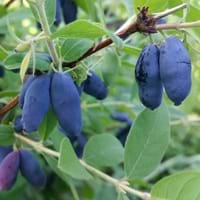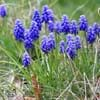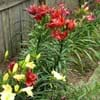What is
Life Span
Perennial
Perennial
Type
Perennial
Flowering Plants, Shrubs
Origin
Eastern Europe
Asia, North America
Types
Not Available
Lonicera caerulea altaica, Lonicera caerulea cauriana, Lonicera caerulea kamschatica
Number of Varieties
Not Available
9
99+
Habitat
Terrestrial
Wet lands
USDA Hardiness Zone
4-9
Not Available
AHS Heat Zone
9-1
Not Available
Sunset Zone
1a, 1b, 2a, 2b, 3a, 3b, 4, 5, 6, 7, 8, 9, 10, 11, 12, 13, 14, 15, 16, 17, 18, 19, 20, 21, 22, 23, 24
Not Available
Habit
Clump-Forming
Cushion/Mound-forming
Information
Plant Size
Minimum Height
10.20 cm
99+
30.50 cm
99+
Minimum Width
15.20 cm
99+
30.50 cm
99+
Plant Color
Flower Color
Yellow, Lavender, Blue Violet
Yellow
Flower Color Modifier
Bicolor
Bicolor
Fruit Color
Not Available
Brown
Leaf Color in Spring
Green, Sea Green
Dark Green
Leaf Color in Summer
Green, Sea Green
Blue Green, Gray Green
Leaf Color in Fall
Green, Sea Green
Blue Green, Gray Green
Leaf Color in Winter
Light Green
Blue Green, Gray Green
Shape
Leaf Shape
Lanceolate
Oval
Thorns
No
No
Season
Plant Season
Spring, Summer
Summer, Fall, Winter
Growing Conditions
Sunlight
Full Sun, Partial Sun
Full Sun, Partial shade
Growth Rate
Medium
Medium
Type of Soil
Loam, Sand
Well drained
The pH of Soil
Neutral
Neutral
Soil Drainage
Well drained
Well drained
Bloom Time
Spring, Late Spring, Early Summer
Late Winter, Spring, Summer
Repeat Bloomer
No
Yes
Tolerances
Drought
Drought
Care
Where to Plant?
Ground
Ground
How to Plant?
By dividing rhizomes, tubers, Seedlings
Seedlings
Plant Maintenance
Medium
Medium
Watering Plants
Watering Requirements
Average Water Needs, Do Not over Water
Get enough water whenever the soil is dry
In Summer
Lots of watering
Lots of watering
In Spring
Moderate
Moderate
In Winter
Average Water
Average Water
Soil
Soil pH
Neutral
Neutral
Soil Type
Loam, Sand
Well drained
Soil Drainage Capacity
Well drained
Well drained
Sun Exposure
Full Sun, Partial Sun
Full Sun
Pruning
Remove damaged leaves, Remove dead branches, Remove dead leaves
Prune for shortening long shoots, Remove damaged leaves, Remove dead branches, Remove dead leaves
Fertilizers
All-Purpose Liquid Fertilizer
All-Purpose Liquid Fertilizer
Pests and Diseases
Red blotch
Red blotch
Plant Tolerance
Drought
Drought
Facts
Flowers
Yes
Showy
Flower Petal Number
Single
Single
Fruits
Showy Fruit
No
No
Edible Fruit
No
No
Fragrance
Fragrant Flower
Yes
Yes
Fragrant Fruit
No
No
Fragrant Leaf
No
Yes
Fragrant Bark/Stem
No
No
Showy Foliage
No
Yes
Showy Bark
No
No
Foliage Texture
Coarse
Bold
Foliage Sheen
Matte
Matte
Evergreen
No
No
Invasive
No
No
Self-Sowing
No
Yes
Attracts
Hummingbirds
Bugs
Allergy
Skin irritation
Not Available
Benefits
Uses
Aesthetic Uses
Showy Purposes
Showy Purposes
Beauty Benefits
Not Available
Not Available
Edible Uses
No
Yes
Environmental Uses
Air purification
Air purification
Plant Benefits
Medicinal Uses
No Medicinal Use
anti-inflammatory, Cardiovascular problems, Eye Problems
Part of Plant Used
Not Available
Fruits, Leaves
Other Uses
Used as Ornamental plant
Food for animals, Food for insects, Used as Ornamental plant, Used for its medicinal properties
Used As Indoor Plant
No
No
Used As Outdoor Plant
Yes
Yes
Garden Design
Alpine, Edging, Mixed Border, Rock Garden, Wall
Bedding Plant, Container, Edging, Edible, Herb / Vegetable, Mixed Border
Scientific Name
Botanical Name
IRIS pumila
Lonicera caerulea
Common Name
Dwarf Iris
honeyberry, blue-berried honeysuckle, sweetberry honeysuckle
In Hindi
Dwarf Iris
Honeyberry
In German
Zwergiris
Honeyberry
In French
Dwarf Iris
baie au miel
In Spanish
Enano Iris
Honeyberry
In Greek
νάνος Ίρις
Honeyberry
In Portuguese
Dwarf Iris
Honeyberry
In Polish
Dwarf Iris
Honeyberry
In Latin
Iris Dwarf
Honeyberry
Classification
Kingdom
Plantae
Plantae
Phylum
Magnoliophyta
Magnoliophyta
Class
Liliopsida
Magnoliopsida
Order
Liliales
Dipsacales
Family
Iridaceae
Caprifoliaceae
Genus
Iris
Lonicera
Clade
Angiosperms, Monocots
Angiosperms, Asterids, Eudicots
Tribe
Irideae
Not Available
Subfamily
Iridoideae
Not Available
Number of Species
Not Available
180
99+
|
||
|
||
|












